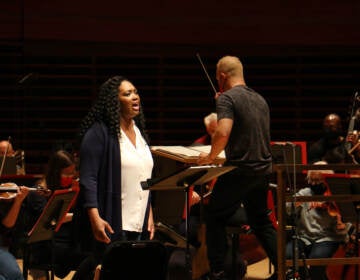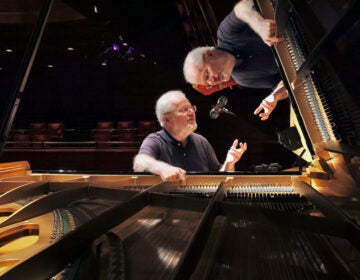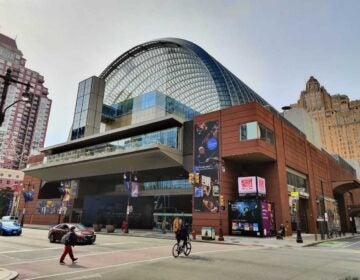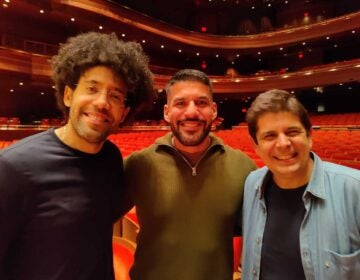Philadelphia Orchestra has new collaborator: artificial intelligence
A white monolith shares the stage with the Orchestra, exploding with 3D imagery generated in real time by an AI classical music lover.
This weekend the Philadelphia Orchestra will be sharing the stage with a giant computer.
At the center of Verizon Hall’s stage in the Kimmel Center stands a 40-foot tall, white monolith reaching the ceiling. It is a digital screen with 8.2 million pixels, each controlled by artificial intelligence.
As the orchestra plays Beethoven’s “Missa Solemnis,” the screen comes alive with swirls and cascades of color. At times it looks like a melting cathedral; other times it appears to be an exploding woven rug.
The computer has not been specifically programmed to do this. Rather the electronic brain is hearing and responding to music on its own, in real time.
Its developer, Refik Anadol, is not entirely in control.
“I will say, 50% of the performance is really machine serendipity, machine decisions, and the other half is human decisions,” Anadol said. “Of course, in the end the performance itself defines many things, like the speed, the feeling, the colors, and where the AI goes.”
Anadol is a Los Angeles-based media artist who has been working with AI and data-based electronic visualizations for 10 years. He has not given his artificial intelligence machine an anthropomorphic name, but refers to it as a “thinking paintbrush.”
For this performance of Beethoven with the Philadelphia Orchestra, Anadol “taught” his system by feeding it hundreds of thousands of images of Renaissance art and architecture, the kind of aesthetics that Beethoven himself would have been consuming when he wrote his celebrated works.
“We are taking from the Renaissance era every single building ever done, every single sculpture ever created, and every single painting ever done,” Anadol said. “These are amazingly large cultural data. We are trying to make an AI to dream these beautiful cultural elements of humanity.”
The system uses fluid dynamics algorithms to generate animation effects resembling flowing water and wind through hair. It often comes across like a psychedelic dreamscape, set to the power of a full orchestra, large chorus, and vocal soloists bringing Beethoven’s grandeur to life.
To Anadol, this is the most ethical application for artificial intelligence.
“AI is a myth that people think in the most negative way, but actually it can be a tool for humanity, for the next journey,” he said. “Like any technology, it has a 50% chance of being used for good reasons. I’m not saying that it will never be bad or used for wrong, but the question is: what else can we do with it, such as creating art, beautiful experiences, and positive applications? That’s, I think, very exciting.”
Anadol’s AI visualizations have accompanied other orchestras in the past, including at the Brucknerhaus in Austria and with the Los Angeles Philharmonic. Normally the visuals are recordings of the machine’s responses to music played back from the stage, but this performance with the Philadelphia Orchestra will be the first time the artificial intelligence machine is responding live to music in real time, answering the age-old question: Do androids dream of electric sheep?
The program of Beethoven coupled with Anadol’s machine will be performed this weekend only in Verizon Hall.

Saturdays just got more interesting.
WHYY is your source for fact-based, in-depth journalism and information. As a nonprofit organization, we rely on financial support from readers like you. Please give today.






